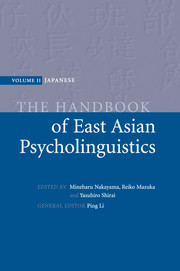Book contents
- Frontmatter
- Contents
- List of figures
- List of contributors
- In memory of Miwa Nishimura
- Preface
- Introduction
- Language acquisition
- 1 Ontogeny of language
- 2 Caregivers' speech
- 3 The intrinsic link between gesture and speech at the prelinguistic stage
- 4 Infant speech perception
- 5 Phonological acquisition
- 6 The mechanism of lexical development: implications from Japanese children's word learning
- 7 The acquisition of nouns and verbs in Japanese
- 8 The acquisition of verbal nouns
- 9 The acquisition of Japanese numeral classifiers
- 10 The acquisition of case markers
- 11 The acquisition of tense and aspect
- 12 On the origin of children's errors: the case of Japanese negation and direct passive
- 13 Binding Theory in UG and first-language acquisition of Japanese
- 14 The acquisition of the particles ne, yo, and no
- 15 The acquisition of linguistic politeness in Japanese
- 16 Children's narrative structures
- 17 Memory talk and testimony in children
- 18 Developmental dyslexia
- 19 Japanese Sign Language
- 20 The role of an innate acquisition device in second-language acquisition
- 21 Japanese, the grammar of reflexives, and second-language acquisition
- 22 Processes in L2 Japanese sentence production
- 23 The development of lexical competence among second-language readers
- 24 Reading in Japanese as a second language
- 25 Intrasentential code-switching in Japanese and English
- Part II Language processing
- References
- Name index
- Subject index
6 - The mechanism of lexical development: implications from Japanese children's word learning
from Language acquisition
Published online by Cambridge University Press: 05 June 2012
- Frontmatter
- Contents
- List of figures
- List of contributors
- In memory of Miwa Nishimura
- Preface
- Introduction
- Language acquisition
- 1 Ontogeny of language
- 2 Caregivers' speech
- 3 The intrinsic link between gesture and speech at the prelinguistic stage
- 4 Infant speech perception
- 5 Phonological acquisition
- 6 The mechanism of lexical development: implications from Japanese children's word learning
- 7 The acquisition of nouns and verbs in Japanese
- 8 The acquisition of verbal nouns
- 9 The acquisition of Japanese numeral classifiers
- 10 The acquisition of case markers
- 11 The acquisition of tense and aspect
- 12 On the origin of children's errors: the case of Japanese negation and direct passive
- 13 Binding Theory in UG and first-language acquisition of Japanese
- 14 The acquisition of the particles ne, yo, and no
- 15 The acquisition of linguistic politeness in Japanese
- 16 Children's narrative structures
- 17 Memory talk and testimony in children
- 18 Developmental dyslexia
- 19 Japanese Sign Language
- 20 The role of an innate acquisition device in second-language acquisition
- 21 Japanese, the grammar of reflexives, and second-language acquisition
- 22 Processes in L2 Japanese sentence production
- 23 The development of lexical competence among second-language readers
- 24 Reading in Japanese as a second language
- 25 Intrasentential code-switching in Japanese and English
- Part II Language processing
- References
- Name index
- Subject index
Summary
Background
Young children face a serious problem of induction in word learning, as there are virtually an unlimited number of candidates for the meaning of a word that can be induced from a single referent (Quine, 1960). However, researchers have converged on the view that young children do not go astray in the labyrinth of the induction problem. Children possess a certain set of principles or biases about how words are mapped onto their meanings, and these principles/biases enable them to map a word to its meaning even at the first exposure to the word (e.g. Gleitman, 1990; Markman & Hutchinson, 1984). For example, young children assume that a new word (noun) refers to the entirety of the referred entity rather than its part, color, texture, or material (Markman, 1989; Landau, Smith & Jones, 1988). They also assume that the word denotes a category, and hence that it should be generalized to other objects of like kind (Hall, 1991; Markman & Hutchinson, 1984). It has been also shown that children use shape similarity as a basis for determining what objects are of “like kind” and what are not (e.g. Golinkoff et al., 1995; Imai, Gentner & Uchida, 1994).
At the same time, these so-called constraint theories are not sufficient to fully explain young children's lexical development, because while word learning constraints/biases help the learning of basic-level object category names, they do not help the learning of other types of nouns such as substance names, proper names, subordinate and superordinate category names. In other words, the word-learning constraint theories say very little about how children infer meanings of words that are not basic-level object category names.
- Type
- Chapter
- Information
- The Handbook of East Asian Psycholinguistics , pp. 48 - 55Publisher: Cambridge University PressPrint publication year: 2006



